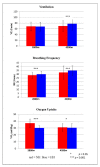Expiratory Peak Flow and Minute Ventilation Are Significantly Increased at High Altitude versus Simulated Altitude in Normobaria
- PMID: 35207593
- PMCID: PMC8875033
- DOI: 10.3390/life12020306
Expiratory Peak Flow and Minute Ventilation Are Significantly Increased at High Altitude versus Simulated Altitude in Normobaria
Abstract
Simulated altitude (normobaric hypoxia, NH) is used to study physiologic hypoxia responses of altitude. However, several publications show differences in physiological responses between NH and hypobaric conditions at altitude (hypobaric hypoxia, HH). The causality for these differences is controversially discussed. One theory is that the lower air density and environmental pressure in HH compared to NH lead to lower alveolar pressure and therefore lower oxygen diffusion in the lung. We hypothesized that, if this theory is correct, due to physical laws (Hagen-Poiseuille, Boyle), resistance respectively air compression (Boyle) at expiration should be lower, expiratory flow higher, and therefore peak flow and maximum expiratory flow (MEF) 75-50 increased in hypobaric hypoxia (HH) vs. normobaric hypoxia (NH). To prove the hypothesis of differences in respiratory flow as a result of lower alveolar pressure between HH and NH, we performed spirography in NH at different simulated altitudes and the corresponding altitudes in HH. In a cross over study, 6 healthy subjects (2 f/4 m, 28.3 ± 8.2 years, BMI: 23.2 ± 1.9) performed spirography as part of spiroergometry in a normobaric hypoxic room at a simulated altitude of 2800 m and after a seven-hour hike on a treadmill (average incline 14%, average walking speed 1.6 km/h) to the simulated summit of Mauna Kea at 4200 m. After a two-month washout, we repeated the spirometry in HH on the start and top of the Mauna Kea hiking trail, HI/USA. Comparison of NH (simulated 4200 m) and HH at 4200 m resulted in increased pulmonary ventilation during exercise (VE) (11.5%, p < 0.01), breathing-frequency (7.8%, p < 0.01), peak expiratory flow PEF (13.4%, p = 0.028), and MEF50 (15.9%, p = 0.028) in HH compared to NH, whereas VO2max decreased by 2%. At 2800 m, differences were only trendy, and at no altitude were differences in volume parameters. Spirography expresses higher mid expiratory flows and peak flows in HH vs. NH. This supports the theory of lower alveolar and small airway pressure due to a lower air density resulting in a lower resistance.
Keywords: air density; altitude; exercise; hypobaria; normobaria; spiroergometry; ventilation.
Conflict of interest statement
The authors declare no conflict of interest.
Figures



References
-
- Basualto-Alarcón C., Rodas G., Galilea P.A., Riera J., Pagés T., Ricart A., Torrella J.R., Behn C., Viscor G. Cardiorespiratory parameters during submaximal exercise under acute exposure to normobaric and hypobaric hypoxia. Apunts. Medicina l’Esport. 2012;47:65–72. doi: 10.1016/j.apunts.2011.11.005. - DOI
LinkOut - more resources
Full Text Sources

